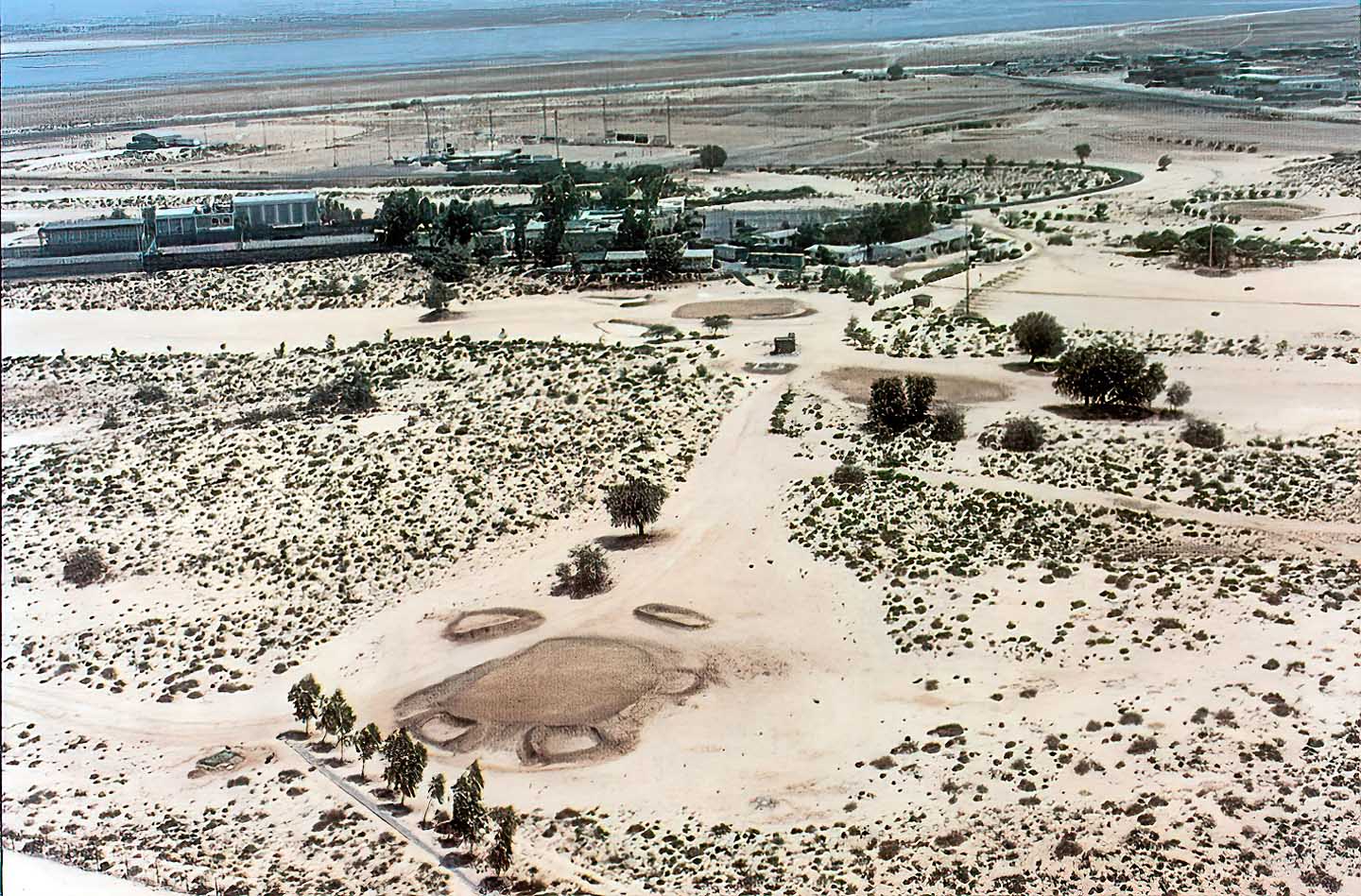
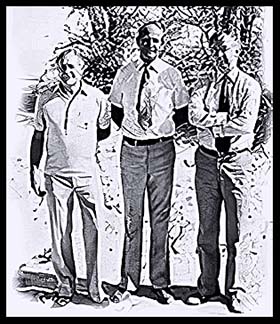
Beginnings 1969: DCC Founders
Dubai's European population grew after oil was discovered in 1967. These Expatriates had nowhere to socialise as Dubai had few Hotels, only a couple of Cinemas and few Restaurants.
Tony Higham (on photo's left) of African & Eastern Est presented the idea of a Club to a meeting of just 150 Expatriates. They agreed to ask Sheikh Rashid for a land grant. Sheikh Rashid previously granted land for The Indian Club in 1964 so there was a precedent.
Arthur Jarman (photo centre) obtained support from prominent local businessman Khalifa bin Juma Al Naboodah. Six Expatriates and Mr Naboodah submitted a formal request to Sheikh Rashid for land with the expectation it would be next to Al Maktoum Bridge. Instead Sheikh Rashid granted land in Ras Al Khor which, in 1969 terms, was a remote desert area.
The only access was a gravel road used by Trucks carrying quarried rock for Port Rashid's construction! These trucks operated day and night with 20 ton loads.
Driving to and from Dubai Country Club was very dangerous.
I have fond memories of picnics under the moon.
We used to cook hamour fish and the Europeans love it.
Khalifa bin Juma Al Naboodah (DCC Founder Member) 1981

Myth and Reality
Myth developed about DCC's origin that has 5 men sitting under a tree dreaming of a building a Club. Their dream turned into reality when Sheikh Rashid gave the land around the tree for DCC. Story is romantic but not true! Reality was lack of roads and scarcity of 4WD vehicles in 1969 meant few Expatriates visited this area prior to the land grant.
Dubai Country Club grew primarily out of a wish for a golf course in Dubai. British RAF built the first sand golf course in Sharjah but this was too far for Dubai Expatriates. Another golf course had been built near Satwa but was small and poorly maintained. "Vision" was for new Golf Course and Clubhouse. That required money! 150 "Members" each contributed Dhs 500 - a large sum in 1969 - which was insufficient to build a Clubhouse.
Commercial Bank of Dubai's local Manager was approached for an unsecured loan. Surprisingly he approved a DHS 20,000 unsecured loan. The Bank Manager was transferred soon after that! Bank's Head Office was not happy. They insisted on a permanent seat on Club Committee so they could "keep an eye" on their investment.
Newly built Clubhouse comprised a small bar and an even smaller kitchen. Members themselves built a nine hole sand Golf Course with borrowed equipment. Club access remained a major problem with Members driving across sand to get to DCC until Sheikh Rashid generously ordered a road to be built to the Club.
DCC formally opens 1971
Dubai Country Club formally opened on 31st March 1971 and soon attracted new Members. DCC's Golf Course proved a major attraction particularly when Dubai's summer arrived.
Dubai's lack of facilities plus the summer heat meant most European families returned to their home countries for the four month summer period. Husbands remained in Dubai. Dubai's Expatriate population became "Men Only"! DCC's Golf Course attracted these "single" men whether they played golf or not.
Friday Golf Competitions offered social contact plus prospect of spending time at the bar without any pressing need to get home.
DCC's Membership trebled by end of the first year and continued growing.
People cannot believe it now, but there was not the money then.
That is why I am very grateful and have happy memories of those people who worked to develop the club in the early days. It was hard work.
Khalifa bin Juma Al Naboodah (DCC Founder Member) 1981
Signatories to DCC Decree
Khalifa bin Juma Al Naboodah
F.M.C. Borrodaile
K.L. Broderick (Citibank Representative)
P.A. Goodwin
R. Blackburn
C. Batts
Mrs T. Old
DCC's Early Years
DCC's initially lacked of basic amenities such as toilets and telephones. Calling a Gulf Radio Taxi was impossible even if the Driver knew DCC's location which generally they didn't. Not all new members were golfers. Non golfers became increasingly resentful at stopping social activities in the small Club House while Golfers had their prize presentations.
1980s Aerial Photo of DCC shows its expanded buildings and 18 hole Golf Course. Dubai Rugby Club and Dharjeeling Cricket are shown as established in the same area. DCC overcame communications problem by buying its own telephone poles and members arranging a cable installation. Telephone Company then agreed to install a telephone. But it was a long time before Taxis Drivers willingly picked up passengers either traveling to or from "remote" DCC.
Installing a swimming pool and tennis courts dealt with meeting family requirements but the small Club House remained a problem. DCC's golfers solved this problem by installing a separate Golf Clubhouse using a redundant prefabricated staff accommodation unit donated by a Construction Company. Golfers completely refurbished this for use as a temporary measure.
This "temporary" building continued in use for another 35 years!
Drama without an Opening Act
DCC approached Dubai Drama Group with a proposal to share costs in building a new Club House extension. An understanding was reached. DCC built a Club House extension incorporating a stage and a sunken sloping floor for seating to meet the Drama Club needs.
The resulting Club House proved unsuited to neither DCC's needs (sunken sloping floor do not accommodate dining tables and the stage was a wasted space) nor Dubai Drama Group since they never staged a performance at DCC.
DCC lived with these shortcomings for several years until another major extension removed both the sunken floor and the stage.
By this time DCC developed a "Grand Plan" for a major development in three stages.
Stage 1 envisaged redevelopment of existing Clubhouse,
Stage 2: Clubhouse extension with new facilities and
Stage 3: New Sports Hall incorporating Squash Courts.
Increasing demand for sports facilities and financial considerations led to Stage 3 being built first. Stage 2 was never built and Stage 1 not built until end of 1980s. By then DCC was well established with a growing membership.
Food Alcohol and Entertainment
DCC's first modest Clubhouse, built by Golfers for Golfers had only a bar and a very small kitchen serving snacks to meet golfers' simple dining needs! Increasing non golfing membership demanded more! DCC employed a Manager/Chef to raise culinary standards. He highlighted Clubhouse shortcomings - the kitchen's size and lack of a dining room. DCC's first Clubhouse expansion solved these problems.
With a dedicated Chef, DCC developed a reputation for "value for money" dining. Maintaining DCC's reputation became difficult as each Chef came then moved on. In 1983 DCC recruited Francois Porte as Head Chef. Francois was French but worked in England and many exotic locations before Dubai. Francois raised DCC's culinary standard to that of Dubai's top hotels. Value for money combined with haute cuisine attracted members and non members alike, a remarkable achievement given DCC's location.
Eventually DCC's need to cut costs restricted Francois' ability to sustain his high standards. Francois was heard to complain (as only French Chefs can) "How do zey expect me to cook with zis, with ZIS?" as he animatedly pointed to a packet of Bird's Eye Frozen Peas!
In 1989 Francois moved to Emirates Golf Club.
Alcohol at DCC
Alcohol was freely available in Dubai in the early 1970s. Hotels, Restaurants, Cafes, Clubs sold alcohol to their customers as did DCC.
Without any warning the Government stopped alcohol sales overnight in 1974. This was a serious threat to DCC's future since alcohol sales provided the major income. Government eventually introduced Liquor Licences restricting serving of alcohol to Hotels, Clubs and non Muslim Residents. DCC obtained their Liquor Licence with difficulty and was now subject to various Rules,Regulations and Laws controlling Alcohol sales and consumption. Inspection by Dubai Police became a regular event, both scheduled and unscheduled.
Live Entertainment

Back in 1970s few people in the Entertainment Industry had heard of Dubai. Dubai Country Club played a significant role in changing that situation.
DCC started staging outdoor performances using their tennis courts. UK Performers were hired and flown into Dubai often in conjunction with Abu Dhabi Golf Club and sometimes local hotels. Flights to and from Dubai were supported by British Airways or Caledonian Airways. These "tours" were generally one night performances at each location. DCC entertained these Performers with desert and wadi tours so they returned home with a favourable impression of Dubai. Word spread on the Entertainment Circuit and more Performers became willing to come to Dubai.
Billy Connolly was among the first to perform at DCC and became a regular visitor to DCC and Dubai. DCC introduced men only "Gentleman's Dinners" where a gourmet dinner was followed by Celebrity "after dinner" speaker flown in from UK. Henry Cooper the Boxer was one of the first speakers. Henry was a popular speaker at DCC and made several return visits. DCC also introduced ladies only "Ladies Dinners" with the same format.
DCC's new Sports Hall paradoxically succeeded where DCC's previous purpose built "theatre" failed. Their Sports Hall became the venue for a number of local stage productions. Brian Wilkie was a regular performer. He went on to be the driving force behind Dubai Community Theatre and Arts Centre
Decline & Rise
DCC's financial difficulties were largely overcome by late 1970s. DCC's Membership increased dramatically due to Dubai's expanding expatriate population. But that brought a change in Membership demographics.
In the early days DCC's Members were mainly "Professional Expatriates" - people who spent their working lives outside their home countries, used to setting up afresh in new countries with minimal facilities. As Dubai grew, demand for skilled and professional workers increased. People being recruited now had never lived and worked overseas. An inducement was they could bring their families with them. Demands on DCC changed. New Members wanted better facilities for their families.

DCC Golf Section
DCC's Golfers established a separate Clubhouse with their own Committee to run their affairs, leading to a "Club within a Club". Financial strength and political control remained with the Club's Committee who decided to redesign and rebuild DCC's Clubhouse and facilities. This included a third Squash Court to meet increasing demand for squash facilities, capable of hosting international squash events.
Squash was seen as a growing sport that enhanced DCC's profile. These ambitious projects meant further bank loans. Internal political differences resulted in DCC's Golf Section not being included in the new development so continued in their prefabricated building.
Changing Circumstances
By 1980s things changed. Dubai was building new housing complexes. Many were self contained communities with swimming pool, tennis courts, squash courts and maybe a Club facility offering food and drinks. New hotels included sports complexes offering Memberships. Expatriates in Dubai had a choice. DCC was no longer the "only show in town"! DCC's Membership declined.
Emirates Golf Club opened in 1989 attracting many of DCC's stalwart Golfing Members with the prospect of playing on grass. DCC began to struggle financially in the early 1990s. As Dubai's Expatriate population grew, Employers realised Dubai was now a desirable place to live and work. Declining economic conditions outside Dubai meant employment conditions could be less generous than previously. New arrivals found many benefits previously enjoyed by Expatriates were no longer available. Salaries became "all encompassing". Employees were expected to fund living expenses out of their salaries. Employer paid Living Allowances (including Club Memberships) were a thing of the past. Attitudes changed.
Families were now content to stay during Dubai's peak summer months, partly due to shorter annual leave periods but also economics and availability of increasing numbers of air conditioned venues. It was no longer a trial for families to remain in Dubai during the summer. But Mothers needed to keep their children occupied during school holidays. DCC offered a facility where children could play and take part in activities in a safe secure environment. Hotel Club Membership became increasingly expensive as did eating out at hotel restaurants.
By late 1990s DCC was again seen by Expatriates as offering "value for money" . DCC's Membership began to grow again.
Gone but the Legacy continues
DCC was established on the traditional "British Club" model by a small group of Expatriates.
In the beginning DCC was "exclusive" and relatively difficult to join - prospective members needed recommending by an existing member i.e. you had to "know" someone. Need for income to support the Club soon led to "The Rules" being relaxed as more expatriates were encouraged to join.
30 plus years after its opening, DCC closed to make way for Dubai's new developments leaving Dubai with a remarkable legacy. Golf in Dubai grew out of DCC's sand course not just the game but the events the game of golf generates. The Desert Classic and DP World's Race to Dubai are descendants of DCC's 1979 first Dubai Open Golf Championship and British Caledonian Pro Am Series.
1979 Dubai Open Golf Tournament attracted golfers from the Gulf Countries, Africa, UK and Pakistan and became a regular event on the golfing calendar. British Caledonian Lions brought professional golfers to Dubai for the first time in the 1970s. Top players such as Brian Barnes, Tommy Horton (both Ryder Cup Team Members) and Ewen Murray (now a Golf Commentator) played golf on DCC's sand course and continued to do so until around 1990. They took away a favourable impression of Dubai and spread the message. Soon more professional golfers were willing to play golf in Dubai.
There are several stories about how Dubai's first grass golf course at Emirates Golf Club came into being but there is no doubt DCC's sand golf course was instrumental in establishing golf in Dubai by showing the level of public interest and golf's potential for to promote Dubai. DCC introduced many non golfers to the game of golf, providing training and education programmes.
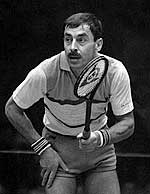
Dubai's Squash grew in stature through DCC's support for the game. Its international standard squash court attracted World Champions Jonah Barrington and Geoff Hunt to Dubai for several exhibition tours. DCC introduced the Dubai International 3s Squash Tournament attracting sponsored Squash Teams from around the World. Tennis, badminton, snooker were all sports played at DCC that brought international players to Dubai. DCC's 1970's foray into live entertainment with professional performers such as Billy Connolly and Cannon and Ball expanded over the years into hosting a variety of events culminating in the 2006 Rock Festival.
Ambition beats Tradition in the End
DCC's became a victim of Dubai's ambitions.
Dubai's development plans for Khor Dubai meant DCC had to close. Arguments that Sheikh Rashid gave the land to DCC were rejected. This was not unusual. Even Government entities found Sheikh Rashid had sometimes not recorded his decisions or issued conflicting instructions. That did not matter in Dubai's early days but as Dubai expanded and Planners and Surveyors began their work these anomalies were found and new decisions made.
DCC closed on November 30th 2007.
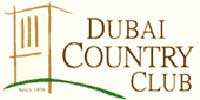 DCC was offered land in a different location plus financial compensation to build a new Clubhouse. The offer was accepted. Planning was in progress but the 2008 Global Financial Crisis intervened. Prospective Members were unwilling to pay the level of fees required plus there were difficulties with the Developers. Eventually the project was abandoned.
DCC was offered land in a different location plus financial compensation to build a new Clubhouse. The offer was accepted. Planning was in progress but the 2008 Global Financial Crisis intervened. Prospective Members were unwilling to pay the level of fees required plus there were difficulties with the Developers. Eventually the project was abandoned.
Dubai Country Club has become part of Dubai's forgotten history
Remembered only by those who knew Dubai as it used to be.

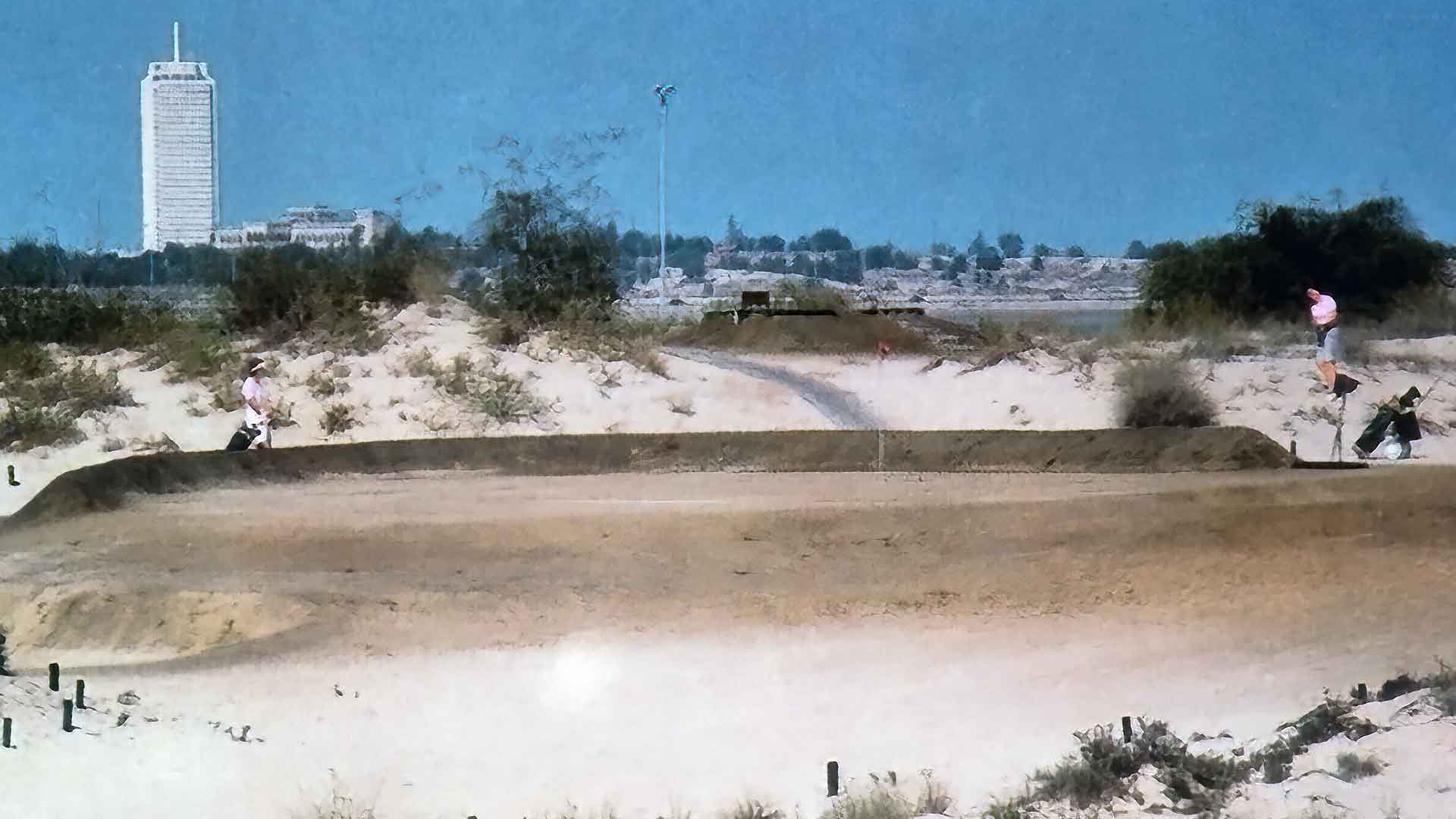







 DCC was offered land in a different location plus financial compensation to build a new Clubhouse. The offer was accepted. Planning was in progress but the 2008 Global Financial Crisis intervened. Prospective Members were unwilling to pay the level of fees required plus there were difficulties with the Developers. Eventually the project was abandoned.
DCC was offered land in a different location plus financial compensation to build a new Clubhouse. The offer was accepted. Planning was in progress but the 2008 Global Financial Crisis intervened. Prospective Members were unwilling to pay the level of fees required plus there were difficulties with the Developers. Eventually the project was abandoned.